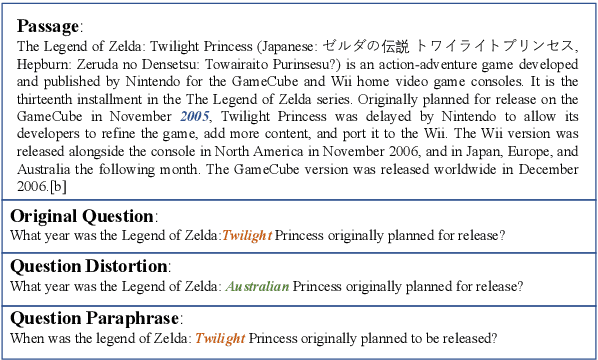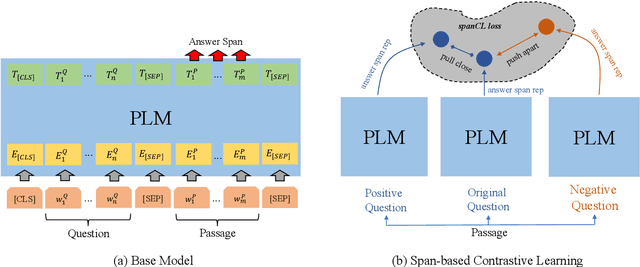Yunjie Ji
Memorizing is Not Enough: Deep Knowledge Injection Through Reasoning
Apr 01, 2025Abstract:Although large language models (LLMs) excel in knowledge recall and reasoning, their static nature leads to outdated information as the real world evolves or when adapting to domain-specific knowledge, highlighting the need for effective knowledge injection. However, current research on knowledge injection remains superficial, mainly focusing on knowledge memorization and retrieval. This paper proposes a four-tier knowledge injection framework that systematically defines the levels of knowledge injection: memorization, retrieval, reasoning, and association. Based on this framework, we introduce DeepKnowledge, a synthetic experimental testbed designed for fine-grained evaluation of the depth of knowledge injection across three knowledge types (novel, incremental, and updated). We then explore various knowledge injection scenarios and evaluate the depth of knowledge injection for each scenario on the benchmark. Experimental results reveal key factors to reach each level of knowledge injection for LLMs and establish a mapping between the levels of knowledge injection and the corresponding suitable injection methods, aiming to provide a comprehensive approach for efficient knowledge injection across various levels.
How Difficulty-Aware Staged Reinforcement Learning Enhances LLMs' Reasoning Capabilities: A Preliminary Experimental Study
Apr 01, 2025Abstract:Enhancing the reasoning capabilities of Large Language Models (LLMs) with efficiency and scalability remains a fundamental challenge in artificial intelligence research. This paper presents a rigorous experimental investigation into how difficulty-aware staged reinforcement learning (RL) strategies can substantially improve LLM reasoning performance. Through systematic analysis, we demonstrate that strategically selecting training data according to well-defined difficulty levels markedly enhances RL optimization. Moreover, we introduce a staged training methodology, progressively exposing models to increasingly challenging tasks, further amplifying reasoning capabilities. Our findings reveal significant cross-domain benefits when simultaneously training models on mathematical reasoning and code generation tasks. Notably, our proposed approach enables a 1.5B parameter model to achieve an accuracy of 42.3\% on the AIME-2024 benchmark, 89.5\% on the MATH-500 benchmark. These results underscore the efficacy of our method in advancing the reasoning proficiency of LLMs. We will open-source our datasets on GitHub and Hugging Face.
1.4 Million Open-Source Distilled Reasoning Dataset to Empower Large Language Model Training
Mar 25, 2025Abstract:The AM-DeepSeek-R1-Distilled is a large-scale dataset with thinking traces for general reasoning tasks, composed of high-quality and challenging reasoning problems. These problems are collected from a multitude of open-source datasets, subjected to semantic deduplication and meticulous cleaning to eliminate test set contamination. All responses within the dataset are distilled from reasoning models (predominantly DeepSeek-R1) and have undergone rigorous verification procedures. Mathematical problems are validated by checking against reference answers, code problems are verified using test cases, and other tasks are evaluated with the aid of a reward model. The AM-Distill-Qwen-32B model, which was trained through only simple Supervised Fine-Tuning (SFT) using this batch of data, outperformed the DeepSeek-R1-Distill-Qwen-32B model on four benchmarks: AIME2024, MATH-500, GPQA-Diamond, and LiveCodeBench. Additionally, the AM-Distill-Qwen-72B model surpassed the DeepSeek-R1-Distill-Llama-70B model on all benchmarks as well. We are releasing these 1.4 million problems and their corresponding responses to the research community with the objective of fostering the development of powerful reasoning-oriented Large Language Models (LLMs). The dataset was published in \href{https://huggingface.co/datasets/a-m-team/AM-DeepSeek-R1-Distilled-1.4M}{https://huggingface.co/datasets/a-m-team/AM-DeepSeek-R1-Distilled-1.4M}.
Think Twice: Enhancing LLM Reasoning by Scaling Multi-round Test-time Thinking
Mar 25, 2025Abstract:Recent advances in large language models (LLMs), such as OpenAI-o1 and DeepSeek-R1, have demonstrated the effectiveness of test-time scaling, where extended reasoning processes substantially enhance model performance. Despite this, current models are constrained by limitations in handling long texts and reinforcement learning (RL) training efficiency. To address these issues, we propose a simple yet effective test-time scaling approach Multi-round Thinking. This method iteratively refines model reasoning by leveraging previous answers as prompts for subsequent rounds. Extensive experiments across multiple models, including QwQ-32B and DeepSeek-R1, consistently show performance improvements on various benchmarks such as AIME 2024, MATH-500, GPQA-diamond, and LiveCodeBench. For instance, the accuracy of QwQ-32B improved from 80.3% (Round 1) to 82.1% (Round 2) on the AIME 2024 dataset, while DeepSeek-R1 showed a similar increase from 79.7% to 82.0%. These results confirm that Multi-round Thinking is a broadly applicable, straightforward approach to achieving stable enhancements in model performance, underscoring its potential for future developments in test-time scaling techniques. The key prompt: {Original question prompt} The assistant's previous answer is: <answer> {last round answer} </answer>, and please re-answer.
A Comparative Study between Full-Parameter and LoRA-based Fine-Tuning on Chinese Instruction Data for Instruction Following Large Language Model
Apr 18, 2023



Abstract:Recently, the instruction-tuning of large language models is a crucial area of research in the field of natural language processing. Due to resource and cost limitations, several researchers have employed parameter-efficient tuning techniques, such as LoRA, for instruction tuning, and have obtained encouraging results In comparison to full-parameter fine-tuning, LoRA-based tuning demonstrates salient benefits in terms of training costs. In this study, we undertook experimental comparisons between full-parameter fine-tuning and LoRA-based tuning methods, utilizing LLaMA as the base model. The experimental results show that the selection of the foundational model, training dataset scale, learnable parameter quantity, and model training cost are all important factors. We hope that the experimental conclusions of this paper can provide inspiration for training large language models, especially in the field of Chinese, and help researchers find a better trade-off strategy between training cost and model performance. To facilitate the reproduction of the paper's results, the dataset, model and code will be released.
Towards Better Instruction Following Language Models for Chinese: Investigating the Impact of Training Data and Evaluation
Apr 16, 2023Abstract:Recently, significant public efforts have been directed towards developing low-cost models with capabilities akin to ChatGPT, thereby fostering the growth of open-source conversational models. However, there remains a scarcity of comprehensive and in-depth evaluations of these models' performance. In this study, we examine the influence of training data factors, including quantity, quality, and linguistic distribution, on model performance. Our analysis is grounded in several publicly accessible, high-quality instruction datasets, as well as our own Chinese multi-turn conversations. We assess various models using a evaluation set of 1,000 samples, encompassing nine real-world scenarios. Our goal is to supplement manual evaluations with quantitative analyses, offering valuable insights for the continued advancement of open-source chat models. Furthermore, to enhance the performance and training and inference efficiency of models in the Chinese domain, we extend the vocabulary of LLaMA - the model with the closest open-source performance to proprietary language models like GPT-3 - and conduct secondary pre-training on 3.4B Chinese words. We make our model, data, as well as code publicly available.
Exploring the Impact of Instruction Data Scaling on Large Language Models: An Empirical Study on Real-World Use Cases
Mar 26, 2023



Abstract:The success of ChatGPT has recently attracted numerous efforts to replicate it, with instruction-tuning strategies being a key factor in achieving remarkable results. Instruction-tuning not only significantly enhances the model's performance and generalization but also makes the model's generated results more consistent with human speech patterns. However current research rarely studies the impact of different amounts of instruction data on model performance, especially in the real-world use cases. In this paper we explore the performance of large language models based on instruction tuning across different scales of instruction data. An evaluation dataset consisting of 12 major online use cases is constructed in the experiment. With Bloomz-7B1-mt as the base model, the results show that 1) merely increasing the amount of instruction data leads to continuous improvement in tasks such as open-ended generation, 2) in tasks such as math and code, the model performance curve remains quite flat while increasing data size. We further analyze the possible causes of these phenomena and propose potential future research directions such as effectively selecting high-quality training data, scaling base models and training methods specialized for hard tasks. We will release our training and evaluation datasets, as well as model checkpoints.
Exploring ChatGPT's Ability to Rank Content: A Preliminary Study on Consistency with Human Preferences
Mar 14, 2023



Abstract:As a natural language assistant, ChatGPT is capable of performing various tasks, including but not limited to article generation, code completion, and data analysis. Furthermore, ChatGPT has consistently demonstrated a remarkable level of accuracy and reliability in terms of content evaluation, exhibiting the capability of mimicking human preferences. To further explore ChatGPT's potential in this regard, a study is conducted to assess its ability to rank content. In order to do so, a test set consisting of prompts is created, covering a wide range of use cases, and five models are utilized to generate corresponding responses. ChatGPT is then instructed to rank the responses generated by these models. The results on the test set show that ChatGPT's ranking preferences are consistent with human to a certain extent. This preliminary experimental finding implies that ChatGPT's zero-shot ranking capability could be used to reduce annotation pressure in a number of ranking tasks.
To Answer or Not to Answer? Improving Machine Reading Comprehension Model with Span-based Contrastive Learning
Aug 02, 2022



Abstract:Machine Reading Comprehension with Unanswerable Questions is a difficult NLP task, challenged by the questions which can not be answered from passages. It is observed that subtle literal changes often make an answerable question unanswerable, however, most MRC models fail to recognize such changes. To address this problem, in this paper, we propose a span-based method of Contrastive Learning (spanCL) which explicitly contrast answerable questions with their answerable and unanswerable counterparts at the answer span level. With spanCL, MRC models are forced to perceive crucial semantic changes from slight literal differences. Experiments on SQuAD 2.0 dataset show that spanCL can improve baselines significantly, yielding 0.86-2.14 absolute EM improvements. Additional experiments also show that spanCL is an effective way to utilize generated questions.
 Add to Chrome
Add to Chrome Add to Firefox
Add to Firefox Add to Edge
Add to Edge